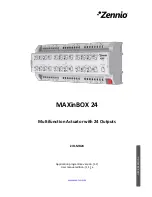
27.10
Sleep Modes
The following tables can be used to calculate the maximum wake time from Sleep or Deep Sleep
depending on the specific application. Depending on the application configuration, each of the
parameters, except for T
FLASH
, add sequential latency to the wake time. Flash restoration happens
in parallel to the other wake processes and its wake time is normally absorbed by the other latencies.
As an example, the wake time for a device in Deep Sleep, with the PIOSC and PLL turned off and
the Flash and SRAM in low power mode is calculated as follows:
Wake Time = T
PIOSCDS
+ T
PLLDS
+ T
SRAMLPDS
T
FLASH
does not contribute to this equation since all other parameters are greater in value.
Note that in Sleep mode the wake time due to a clock source is zero because the device uses the
same clock configuration in Run mode; thus, there is no latency involved with respect to the clocks.
Table 27-27. Wake from Sleep Characteristics
Unit
Max
Nom
Min
Parameter Name
Parameter
Parameter
No
µs
N/A
a
-
-
Time to restore PIOSC as System Clock in Sleep
mode
T
PIOSC
D1
µs
N/A
b
-
-
Time to restore MOSC as System Clock in Sleep
mode
T
MOSC
D2
µs
N/A
c
-
-
Time to restore PLL as System Clock in Sleep mode
T
PLL
D3
µs
39
-
-
Time to restore LDO to 1.2 V in Sleep mode
T
LDO
D4
µs
5
-
-
Time to restore Flash to active state from low power
state in Sleep mode
T
FLASH
D5
µs
15
-
-
Time to restore SRAM to active state from low
power state in Sleep mode
T
SRAMLP
D6
µs
15
-
-
Time to restore SRAM to active state from standby
state in Sleep mode
T
SRAMSTBY
D7
a. Because the PIOSC is enabled in both Run and Sleep Mode for this configuration, no restoration time is required.
b. Because the MOSC is enabled in both Run and Sleep Mode for this configuration, no restoration time is required.
c. Because the PLL is enabled in both Run and Sleep Mode for this configuration, no restoration time is required.
Table 27-28. Wake from Deep Sleep Characteristics
Unit
Max
Nom
Min
Parameter Name
Parameter
Parameter
No
Deep Sleep
Clock Cycles
a
14
-
-
Time to restore PIOSC as System Clock in
Deep Sleep Mode
T
PIOSCDS
D8
ms
18
-
-
Time to restore MOSC as System Clock in
Deep Sleep Mode
T
MOSCDS
D9
clocks
1 cycle of Deep
Sleep Clock + 512
cycles of PLL
reference Clock
a
-
-
Time to restore PLL as System Clock in
Deep Sleep Mode
T
PLLDS
D10
µs
39
-
-
Time to restore LDO to 1.2 V in Deep Sleep
Mode
T
LDODS
D11
µs
5
-
-
Time to restore Flash to active state from
low power state
T
FLASHLPDS
D12
µs
15
-
-
Time to restore SRAM to active state from
low power state
T
SRAMLPDS
D13
1843
June 18, 2014
Texas Instruments-Production Data
Tiva
™
TM4C1294NCPDT Microcontroller
















































